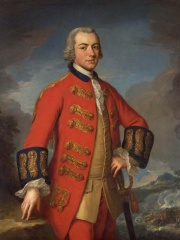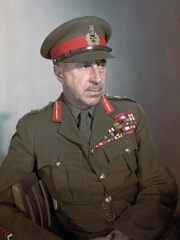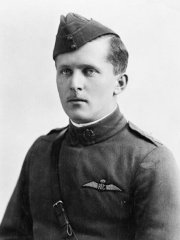


The Most Famous
MILITARY PERSONNELS from Canada
This page contains a list of the greatest Canadian Military Personnels. The pantheon dataset contains 1,468 Military Personnels, 3 of which were born in Canada. This makes Canada the birth place of the 60th most number of Military Personnels behind Portugal and Indonesia.
Top 3
The following people are considered by Pantheon to be the most legendary Canadian Military Personnels of all time. This list of famous Canadian Military Personnels is sorted by HPI (Historical Popularity Index), a metric that aggregates information on a biography’s online popularity.

1. Henry Clinton (1730 - 1795)
With an HPI of 50.35, Henry Clinton is the most famous Canadian Military Personnel. His biography has been translated into 19 different languages on wikipedia.
General Sir Henry Clinton, KB (16 April 1730 – 23 December 1795) was a British Army officer and politician who sat in the House of Commons between 1772 and 1795. He is best known for his service as a general during the American War of Independence. He arrived in Boston in May 1775 and was the British Commander-in-Chief in America from 1778 to 1782. He was a Member of Parliament for many years due to the influence of his cousin Henry Pelham-Clinton, 2nd Duke of Newcastle. Late in life, he was named Governor of Gibraltar, but he died before assuming the post.

2. Harry Crerar (1888 - 1965)
With an HPI of 49.92, Harry Crerar is the 2nd most famous Canadian Military Personnel. His biography has been translated into 18 different languages.
General Henry Duncan Graham Crerar (28 April 1888 – 1 April 1965) was a senior officer of the Canadian Army who became the country's senior field commander in the Second World War as commander of the First Canadian Army in the campaign in North West Europe in 1944–1945. A graduate of the Royal Military College of Canada, in Kingston, Ontario, Crerar was commissioned as a lieutenant in the Non-Permanent Active Militia in 1909, serving with the 4th Battery, Canadian Field Artillery, which was based in Hamilton, Ontario. He rose to the rank of lieutenant-colonel in the artillery in the First World War, during which he was mentioned in despatches and made a member of the Distinguished Service Order (DSO). Electing to remain in the army as a professional soldier after the war, he attended the Staff College, Camberley, from 1923 to 1924, and the Imperial Defence College in 1934. He was appointed Director of Military Operations & Military Intelligence in 1935 and Commandant of the Royal Military College of Canada in 1939. During the Second World War he became General Officer Commanding the 2nd Canadian Infantry Division, which was then stationed in England, in 1941. He was promoted to lieutenant-general and assumed command of I Canadian Corps, fighting briefly in the Italian Campaign. In March 1944 he returned to the United Kingdom where he assumed command of the First Canadian Army which, although designated the Canadian First Army, contained a significant amount of British and Polish troops, including the British I Corps and the Polish 1st Armoured Division. Under Crerar's command, the First Canadian Army fought in the latter stages of the Battle of Normandy in July−August 1944, participating in Operation Totalize, Operation Tractable and the Battle of the Falaise Pocket, before being tasked with clearing the Channel Coast. Crerar was promoted to full general on 16 November 1944, becoming the first Canadian officer to hold that rank in the field. During Operation Veritable, the battle for the Rhineland in 1945, the First Canadian Army controlled nine British divisions. The Army became more Canadian with Operation Goldflake, the redeployment of the I Canadian Corps from Italy, and played a key role in the liberation of the western Netherlands in April 1945, shortly before the end of World War II in Europe. With the war over, Crerar retired from military service in 1946 and, despite his many achievements, soon faded into relative obscurity until his death in 1965. J. L. Granatstein wrote of Crerar that: "No other single officer had such impact on the raising, fighting, and eventual disbanding of the greatest army Canada has ever known. Crerar was unquestionably the most important Canadian soldier of the war."

3. Billy Bishop (1894 - 1956)
With an HPI of 47.09, Billy Bishop is the 3rd most famous Canadian Military Personnel. His biography has been translated into 18 different languages.
Air Marshal William Avery Bishop, (8 February 1894 – 11 September 1956) was a Canadian flying ace of the First World War. He was officially credited with 72 victories, making him the top Canadian and British Empire ace of the war, and also received a Victoria Cross. During the Second World War, Bishop was instrumental in setting up and promoting the British Commonwealth Air Training Plan.
Pantheon has 3 people classified as military personnels born between 1730 and 1894. Of these 3, none of them are still alive today. The most famous deceased military personnels include Henry Clinton, Harry Crerar, and Billy Bishop.
Deceased Military Personnels
Go to all Rankings
Henry Clinton
1730 - 1795
HPI: 50.35
Harry Crerar
1888 - 1965
HPI: 49.92
Billy Bishop
1894 - 1956
HPI: 47.09

Which Military Personnels were alive at the same time? This visualization shows the lifespans of the 3 most globally memorable Military Personnels since 1700.





